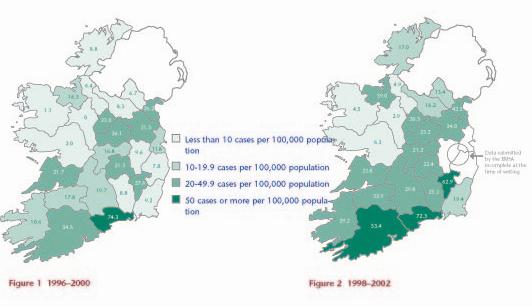Long, Jean (2005) Occasional Paper 14: Trends in treated problem cannabis use in the seven health board areas outside the Eastern Regional Health Authority, 1998 to 2002. Drugnet Ireland, Issue 13, Spring 2005, p. 9.
| Preview | Title | Contact |
|---|---|---|
|
PDF (Drugnet Ireland, issue 13)
- Published Version
407kB |
The findings presented in this paper1 indicate that the number of people treated for cannabis use outside Dublin and counties Kildare and Wicklow trebled between 1998 and 2002, from 14.7 to 50.5 per 100,000 of the 15–64-year-old population. In total, 70 per cent of those who sought treatment for problem cannabis use reported that it was their main problem drug. 1
The increase in the numbers treated may be explained by a combination of factors, such as an increase in access to treatment centres, an increase in the number of centres reporting cases to the National Drug Treatment Reporting System, or a possible increase in cannabis supply.

Regional trends show that the rate of new cases (per 100,000 of the 15–64-year-old population) presenting for treatment, when compared with the period 1996–2000, tended to be higher between 1998 and 2002, with demand for treatment spreading to the south-east and north-west of the country. The increase in the rates treated between these two periods was greatest in Carlow (62.9, up from 27.6), Sligo (39.0, up from 16.3), followed by Cork (53.4, up from 34.5) and Kerry (29.2, up from 10.6).
There was a small decrease in the proportion of cannabis cases that reported using other drugs as well as cannabis, from 83 per cent in 1998 to 78 per cent in 2002, although polydrug use remained a common practice. Ecstasy and alcohol were the most common second drugs used in conjunction with cannabis as a main problem drug.
When the socio-demographic characteristics of treated cannabis users were examined, important patterns were identified. Between 1998 and 2002, the number of new cannabis cases under 18 years old who received treatment increased from 21 per cent to 31 per cent, and an increasing number reported that they were still attending school. Those aged 17 years or under require different approaches to treatment. Although the vast majority of treated cases were male, there was a small rise in the number of females attending for treatment with cannabis as their main problem drug.
1. Kelleher T, Long J, Kelly F and Sinclair H (2004) Trends in treated problem cannabis use in the seven health board areas outside the Eastern Regional Health Authority, 1998 to 2002. Occasional Paper 14. Dublin: Health Research Board.
Repository Staff Only: item control page